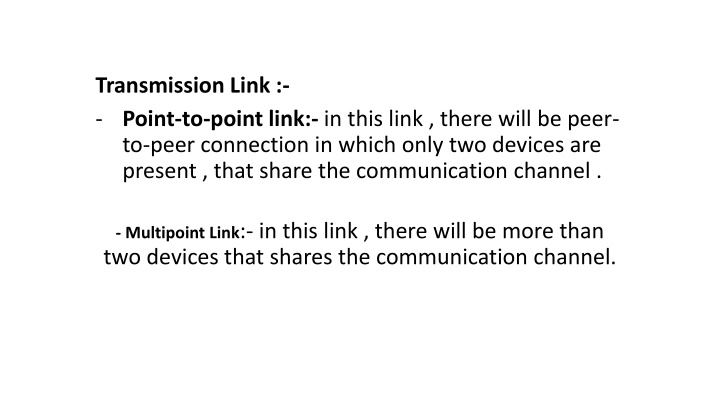
Transmission Links and Media in Networking
Learn about point-to-point and multipoint links, guided and unguided transmission media, and the types and usage of guided transmission media like twisted pair cables. Explore the advantages and disadvantages of using twisted pair cables in different networking environments.
Download Presentation

Please find below an Image/Link to download the presentation.
The content on the website is provided AS IS for your information and personal use only. It may not be sold, licensed, or shared on other websites without obtaining consent from the author. If you encounter any issues during the download, it is possible that the publisher has removed the file from their server.
You are allowed to download the files provided on this website for personal or commercial use, subject to the condition that they are used lawfully. All files are the property of their respective owners.
The content on the website is provided AS IS for your information and personal use only. It may not be sold, licensed, or shared on other websites without obtaining consent from the author.
E N D
Presentation Transcript
Transmission Link :- - Point-to-point link:- in this link , there will be peer- to-peer connection in which only two devices are present , that share the communication channel . - Multipoint Link:- in this link , there will be more than two devices that shares the communication channel.
Transmission Media :- It can be broadly classified into two types - Guided Transmission Media:- in this type of media , a physical path is established between source and destination. The signal or electrical impulse uses this path for transmission which is in the form of electromagnetic waves. Different types of guided Transmission Media are twisted pair, coaxial cable, optical fiber.
- Unguided Transmission Media:- in this type of media , there is no physical path between source and destination. this media is also known as wireless Transmission Media which does not guide the waves but provides a method or a way for transmitting them. Waves are propagated through air, vacuum, atmosphere. Different types of unguided Transmission Media are satellite microwave transmission, terrestrial microwave transmission, radio waves transmission and infrared waves.
Types of Guided Transmission Media:- 1- Twisted Pair Cable:- Twisted Pair Cables are most commonly used guided transmission media. In twisted pair cable, two ordinary copper wires which acts as conductors are twisted around one another, so as to reduce the disturbance caused by electromagnetic waves or due to crosstalk between two adjacent circuits.
Usage of Twisted Pair Cable:- 1- Twisted Pair Cables are used both for analog and digital signals transmission. 2- They are generally used in homes and business computers for connecting them to telephone exchange network. 3- Higher grade of twisted wire is used for horizontal wiring in LAN installation. 4- Twisted Pair Cables are used for supporting voice data that is transmitted using analog signals.
Twisted Pair Cables are less expensive than coaxial cable and fiber optics. There are two types of twisted pair cables. Unshielded Twisted Pair (UTP)Cable :- In UTP , there is no shielding around the twisted pair.UTP are generally used In telephone companies and for computer networking. Advantages of UTP:- It is very easier to work. Installation procedure is easy. Disadvantage of UTP:- Due to lack of shield UTP is highly susceptible to the electromagnetic interference.
Shielded Twisted Pair (STP)Cable :- In STP there is a tough protected shield over each pair of copper wire that is used to reduce the electromagnetic interference that occurs during transmission. Advantages of STP:- Reduces the external interferences. Disadvantages of STP:- Harder to work. Expensive when compared to UTP.
2- Coaxial Cable:- It is most preferred guided transmission media for transmitting signals. It comprises of two conductors. Inner conductor which is surrounded by dielectric system. Outer conductor which surrounds the dielectric system. Outer conductor is covered by protective shield called jacket.
Types of Coaxial Cable:- 1- Flexible coaxial cable. 2- Rigid coaxial cable. Flexible coaxial cable is most widely used coaxial cable. Usage of Coaxial Cable:- Coaxial cables can be used for both long and short distance transmissions. In longer distance it used for connecting television and radio networks. Coaxial cables are used in telephone companies. They are used in business, installing Ethernet and other type of LAN.















